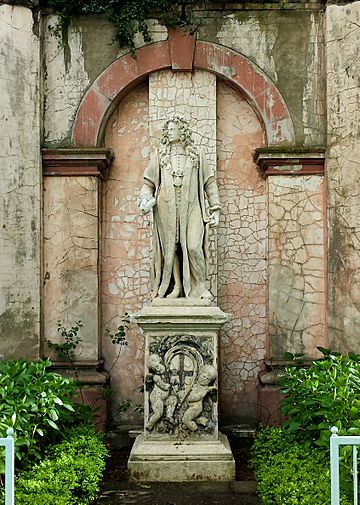Statue of Robert Clayton facts for kids
Quick facts for kids Statue of Robert Clayton |
|
|---|---|

The statue in 2015
|
|
| Artist | Grinling Gibbons |
| Completion date | c. 1714 |
| Type | Sculpture |
| Medium | Marble |
| Subject | Sir Robert Clayton |
| Location | Lambeth, London |
| 51°29′57″N 0°07′12″W / 51.4992°N 0.1201°W | |
|
Listed Building – Grade I
|
|
| Official name | Statue of Robert Clayton at North Entrance to Ward Block of North Wing at St Thomas' Hospital |
| Designated | 30 May 1979 |
| Reference no. | 1319925 |
The statue of Robert Clayton is a marble sculpture located at the entrance of the North Wing of St Thomas' Hospital in Lambeth, London. The famous sculptor Grinling Gibbons created it around 1700–1714. Sir Robert Clayton was a successful banker and politician. He also served as the Lord Mayor of London. As the head of St Thomas' Hospital, he was in charge of completely rebuilding the hospital and its church in the late 1600s. In 1979, the statue was given a special status as a Grade I listed structure. This means it is a very important historical artwork.
Contents
What Does the Statue Look Like?
The statue is made from white marble. It stands on a matching marble base, called a plinth. Sir Robert Clayton is shown wearing his official robes. He also has a long, curly periwig and a pigtail. In his hand, he holds a rolled-up paper, which is called a scroll. The plinth below the statue is decorated with small, winged figures known as cherubs. It also has a message written in Latin.
The Story of Sir Robert Clayton
Robert Clayton was born in 1629. He came from a humble background. He started his career by managing land for others. Later, he became a very successful banker. By the 1670s, he had become extremely wealthy. A writer named John Evelyn even called him "this prince of citizens." He said no one else had such a grand home or threw such amazing parties.
Clayton also became a Member of Parliament (M.P.). This meant he helped make laws for the country. He worked on many different committees in Parliament. In 1692, he became the President of St Thomas' Hospital. He held this important job until he passed away in 1707.
Rebuilding St Thomas' Hospital
St Thomas' Hospital first started as a place for sick people. It was connected to the Church of St Mary Overie in Southwark in the 1100s. By the late 1600s, the hospital buildings were old and falling apart. Sir Robert Clayton decided to rebuild the entire hospital. He hired an architect named Thomas Cartwright for the project. Cartwright was also a governor of the hospital.
The new hospital buildings were made of red brick. They were built in a classical style, which was popular at the time. The construction finished in 1709, just after Clayton's death. The statue was ordered around this time. It was made to remember Sir Robert Clayton's huge contribution to the hospital.
Historians have different ideas about when the statue was actually finished. Some sources say 1701–1702. However, the official Historic England listing says 1714. This later date is supported by a message carved on the statue's base. The job of creating the statue went to Grinling Gibbons. He was paid £50 to carve the statue from the "best Statue Marble." He received another £150 when the work was completed.
In 1872, the hospital was completely rebuilt again. This time, it moved to a new location further along the River Thames in Lambeth. The statue of Sir Robert Clayton was also moved to its current spot at that time. In 1979, the statue was given its Grade I listing. This is the highest level of protection for historical buildings and structures. It means they are of "exceptional interest."
Why the Statue Was Removed
In May 2020, a man named George Floyd was killed in the United States. This led to many protests around the world against racism. In the United Kingdom, people also protested. In Bristol, a statue of Edward Colston was pulled down. Colston was involved in the slave trade. This event started a bigger discussion in the UK about statues of people connected to slavery.
Sir Robert Clayton was a shareholder in the Royal African Company. This company was founded in 1660 and played a major role in the slave trade. Because of this connection, on June 11, 2020, the Guy's and St Thomas' NHS Foundation Trust made an announcement. They said that Sir Robert Clayton's statue, along with another statue of Thomas Guy, would be moved out of public view.

